
The M14 was supposed to replace everything. The selector switch would go right where the button is on the one you see here.
Your current, black aluminum, hated-by-politicians rifle differs from previous military rifles in, oh, just about every way possible. The AR-15/M16/M4 (let’s just keep it simple, and refer to all of them as the “AR”) is a self-loading rifle that feeds from a box magazine and uses the direct-gas impingement operation system (aka, DI system). In most instances, it isn’t a machine gun and it isn’t an assault rifle, even though it gets called that by many.
And, just to get things on the correct footing, nowhere in any book I ever write on the AR will you ever read of me describing it as a weapon, unless it is so-used. That is, a weapon is what you use in a fight. In legal terms, it is the tool you use in any action under legal scrutiny. You do not shoot in a match with a weapon. You do not go hunting, or varmint plinking, with a weapon. Can it be a weapon? Yeah, sure, you betcha. But to describe it always as “a weapon” is to be sloppy with the English language, and I try very hard not to be sloppy. And where I do use that term, it is a deliberate choice.
The AR was not developed, like the M1 Garand or the M14, by the military, which tested, re-tested and modified as the process continued. It was a far messier process than that. The M1 Garand took almost twenty years to come to fruition, and its inventor, John Garand, had to be fast on his feet several times in that process to keep his baby from being killed. Post-WWII, the US Army Ordnance department spent a decade and millions of dollars “improving” the Garand, ending with the M14.
While the US Army was laboring to disgorge the M14, itself a barely-modified M1 Garand, an aerospace company by the name of Armalite (not the same company that today bears the name) was working on lightweight alloys and space-age designs. The designer there, Eugene Stoner, came up with an amalgam of design highlights and assembled them into a rifle with lightweight aluminum receivers. The result was a .308 rifle that weighed significantly less than then-current .308 rifles: the M14, G3 and the FAL.
Alas for Armalite, the militaries of the world, dragged along kicking and screaming by the US Army, had settled on .308, and since they had to use .308 they insisted on going with their own designs. They could not fight off being strong-armed into caliber, but by god they were going to make the rifle at home, and not depend further on Uncle Sam’s largesse.
Armalite then shopped the prototype around, and also down-sized it. Colt picked up the option to make the rifle for the sum of $75,000 and a small percentage of future profits.
The new Armalite was shown around the world, demonstrated anyplace someone showed interest, until someone managed to get it into the hands of General Curtis LeMay. LeMay was in charge of SAC, and was a WWII combat veteran. As an Army Air Force General in WWII, he was responsible for basically burning Japan to the ground in the last year of the war. SAC in the late 1950s and early 1960s meant B-52 bombers, loaded with nukes, waiting on runways to be flown north and at the Soviets. And B-52s loaded with nukes required armed guards.

The M14 was supposed to replace everything. The selector switch would go right where the button is on the one you see here.

The AR receiver is carved out of an aluminum forging, and is just the shell that holds the parts. It does not work like the receiver of an M1 Garand or M14.

When it comes to waging war, rifles are way down the list of important tools to the planners. Here is a display of torpedoes, ready to be loaded into Soviet subs, in a sub base carved out of a mountain. They said there were never any nukes there, but you gotta wonder.
The Air Force had been created as a separate arm after WWII, and was still very prickly about their newly-won independence from the Army. However, the small arms the SAC guards used, primarily M1 and M2 carbines, had to be serviced by the Army. Not that the Air Force didn’t have the skill to do it, but the Army had kept hold of all the parts, tools, armorers classes and institutional knowledge, and they weren’t giving it up. LeMay, shown the AR-15 rifle at a barbeque, shot the new Armalite, liked it, and immediately ordered enough to arm his base guards.
This, and the subsequent history, is all covered in great detail in a number of books. If you really want the blow-by-blow of how it all happened, they are available for your education. In this book, we will cover use and maintenance, but in order to do that well, it will help to have a grasp of the history, messy and messier, that got so much mis-information in print.
Colt was very happy. Once the Air Force bought the AR-15s, the company was “in the system.” That is, it now had an official government stock number, and if someone else wanted some, they could apply for Armalite rifles made by Colt by using the stock number and sending a payment.
Enter Robert McNamara. A successful engineer, salesman and President of Ford Motor Company, he was brought into the government as the Secretary of Defense. (Oh, and he had been an analyst in WWI, working under General LeMay. Not that that influenced the AR-15/M16 situation.) He immediately began applying business practices to defense habits, one focus being the Ordnance department. The Ordnance department had, as I mentioned, labored to design the M14. In the process of developing, testing, and adopting the M14, the Ordnance department and the Army had over-promised and under-delivered. By the early 1960s, the M14 was proven to not be less expensive to produce than the M1 Garand, as had been promised. Also, it provided no advantage over the Garand in recoil, weight, ammunition payload or size. It did have a shorter cartridge, and it did hold more rounds, but that was pretty much it.
In fact, it was also horribly behind schedule in procurement. At the time of the Berlin Blockade in 1961, it was discovered that the Berlin Brigade was not armed with the new rifle, and was still using M1 Garands. In an earlier work, I looked into manufacture and issue rates of the time and calculated that, at the rate the Army was getting M14s, they would have had the entire Army switched over to M14s by 1976. This, with a rifle officially adopted in 1957.
The problem was that we were by the mid-1960s in an increasingly hot war. The Army needed rifles, and they did not need long-range rifles, capable of delivering a killing blow at 1,000 yards. In Vietnam, the locations where you could see 1,000 yards were limited, and the VC and NVA became quite aware that standing in the open was asking to get shot. So they didn’t.
The lightweight, compact, low-recoiling and reliable Armalite was just the thing for a close-range war. So, the Army was ordered to adopt it. The resulting cluster-bleep would have been comical, except there was a war on. The Army said, “Fine, but we need Ordnance to de-bug it first.” To which the smart young guys, the whiz-kids, the ones McNamara had brought in, remembered the debacle of the M14 and said “No way, you’ll just stall it until you can kill it.” Which was true. Referring to the demo, round-the-world tour of the AR-15, they countered, “The prototype went 40,000 rounds without a malfunction, it is perfect, use it as-is.”
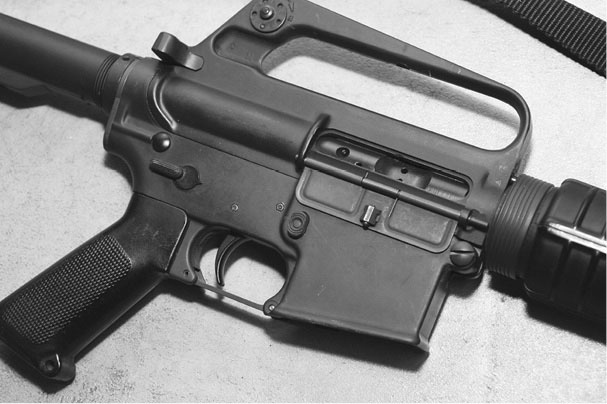
An original Colt, here an early SP1, lacking a forward assist, fences and a push-pin takedown front pin. This was state of the art, ca. 1967.
Every time the Army suggested a change, an upgrade, an improvement, they were nixed. Why? According to the “whiz kids” in Defense, “It was perfect as it was.” And, they knew the Army wanted to kill it, and figured every excuse was just that, an opening to nix the change.
The Army tried to kill it by claiming the useful range it had was too short, in effect moving the goalposts, until they insisted on a minimum level of retained energy at 500 yards. The ammo companies improved the round, and Colt altered the rifle to match.
And then it went off to combat, where at first it seemed to do OK. Then, reality raised its ugly head.
The Army had a bazillion .30 cleaning kits in warehouses across the country. After all, for over half a century, through two World Wars, a police action and countless firing ranges and barracks, they had used .30 rifles, light, medium and heavy machine guns, so they had a multi-war supply of rods, brushes and patches on hand. And none of them would fit an AR.

The first tele-stocks had two positions - open or closed. We got intermediate stops later.
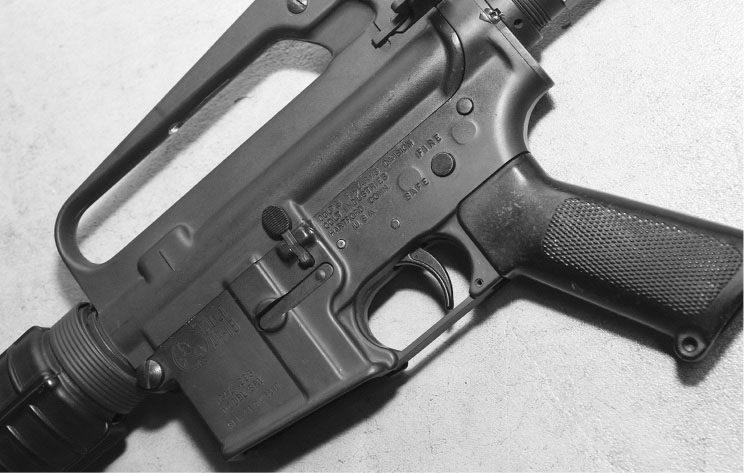
The earliest AR-15s were so-marked, regardless of semi or select-fire. That’s right, the first batch of these that were machine guns were not marked as M16s.
The earliest rifles were AR-15, and marked so, even when they were select-fire. I’ve seen a lot of AR-15-marked rifles that were, for all intents and purposes, M16s, but they were made too early in the process to be marked “M16”.
As a result, grunts in Vietnam were writing home for .22 cleaning kits, since the Army had none.
Then, volume production and use began to show problems, big time. The original ammunition had used a special powder, one with a burn rate that worked properly with the direct-gas system. (Since the system ports the gas directly back into the receiver, it can be quite sensitive to the pressure remaining in the bore when the bullet passes the port, known as the “port pressure.”) That powder maker could not produce the powder used in developing the rifle and cartridge, not in the volume needed for wartime needs. So, the Army asked a different powder maker to provide a suitable powder. The replacement powder had a different burn rate, one not suited to the DI system. The port pressure was too high. The cyclic rate of the rifles with the old ammo was 700-750 rpm. Driven harder by the new powder, the rifles when given a final test before shipping cycled at over 900 rpm. Colt had to ask for continual variances from the specifications, in order to ship the needed rifles.
I can just imagine the phone calls. “Look, you guys sent us the ammo to use and test. The rifles are cycling over 900 rpm with your ammo. Either give us a variance to ship as-is, or ship us the old ammo to test with.” There was a war on, and no more of the old ammo to be had, so the rifles got a variance, and got shipped.
Adding to the problems, the new powder was basically the same old powder used in 7.62X51 cartridges. It had a chemical in it to reduce flash, known as a flash retardant. In loading cartridges for the M14 and machine guns in 7.62, two percent of this chemical in the powder mix was no big deal, and reduced visible flash very nicely. The gas system of the M14 and the M60 shrugged it off as if it wasn’t even in there. In the AR, two percent was too much. It hardened the powder residue to a hard scale, a scale difficult to clean off if not scrubbed immediately, and if not cleaned off, one that caused difficulty in function.

In the early days, barrel markings were easy. There was only one twist (1/12) and your choices were chromed or not.
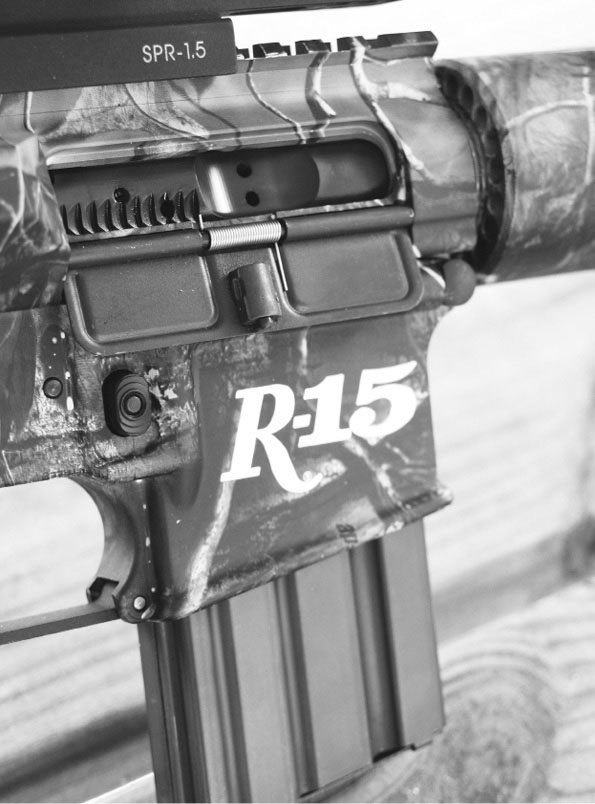
The AR is now common, so common that manufacturers who would not have previously considered it are in the market.
The Army had suggested using hard-chrome plating on the chambers and bore, as Stoner had done with his original .308 rifle. The whiz kids had turned that down, assuming it was more Army stalling, and the resulting rust (gee, bare steel in a jungle environment, who could predict rust?) caused even more function problems. In all fairness, the M1 Garand had been used in jungles, and it did not have a chrome-plated chamber or bore. But it was a .30 rifle, with big, heavy moving parts that didn’t care about a little powder residue.
The Army had to de-bug the rifle while combat was going on, and the resulting problems gave the AR a reputation for unreliability and fragility it was a long time getting over. In some minds, it still has not overcome that early rep.
You will still hear and read people recounting those problems as if they had happened yesterday, and that the Army, the manufacturers, and the politicians have done nothing to change them. Not true, although we can’t give a lot of credit to the politicians. However, and to the great distress of those using or building ARs, the minor problems that remained were not viewed as minor. They were swamped by the overwhelming attitude of, “These things failed their owners in the jungle, they are never to be trusted.”
By 1971, the Army had solved all the big problems. The barrels had the bore and chamber hard-chromed. The powder problem had been addressed, at least as far as the flash retardant was concerned, and the cyclic rate was down to where it worked better. They had done so without making the rifle heavier or larger, and it was still a lightweight, handy rifle. It was never going to satisfy the .308 lovers, but it would do its job.
Then, after we had extricated ourselves from Vietnam, the spectre of the Soviets rose again. By the mid-1970s we were out of the jungles and back to the plains, forests and cities of Europe. And the Soviets were going to have body armor. (Cue ominous drum roll, and eerie music.) We needed ammo that would reach through armor. Meanwhile, the Marine Corps, never happy with the M16, was agitating to have a rifle that could actually allow them to post “proper” scores on the qualification course, one that went out to 500 meters.

The M16 replaced the M14, mightily annoying many marines at the time. Two CH-46Es unload Marines off into combat north of Phu Bai, South Vietnam, during Operation Hastings, 1966.
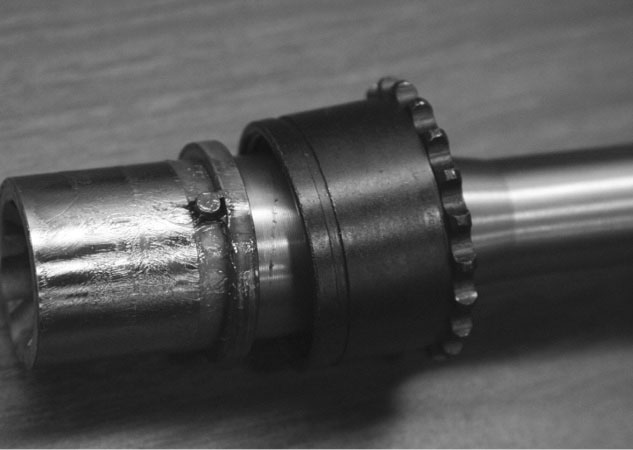
The bolt of the AR locks directly into the rear of the barrel, in the barrel extension. The barrel locks onto the receiver by means of the barrel nut, the black part in this photo. The receiver doesn’t hold the pressure of firing.
Now, again, you have to keep this in context. In the 1970s, there was no GPS, there were no JDams, no digital trickery of any kind. Marines who hit the beach (and that was their job) still depended on naval gunfire and air support, both of which were done by voice, over radio frequencies.
Directing naval gunfire or air support was, “Two hundred meters from the wrecked white building, on a bearing of one hundred and thirty five degrees magnetic north from violet smoke. Fire and wait correction.”To solve their problems, soldiers in a Marine rifle company that hit the beach pretty much had only what they hauled off the landing craft themselves. A rifle squad might be tasked with the job of keeping the enemy machine gun in a building ahead of them busy until the company commander could get the mortar team on it. Or until the off-loaded tank got un-stuck from the mud.
The M16A1, with barely-adjustable sights, a light bullet with a sucky ballistic coefficient, and thus a poor trajectory, was unsuited to a fire team hammering a machine gun position with aimed semi-auto fire, keeping it busy until a bigger hammer could be brought to bear. So in the early 1980s, the M16 was tested for improvements and the new rifle was produced to “solve” those problems.
The resulting M16A2 had a heavier barrel, to allow the USMC to use a sling as an aiming aid, which the skinny barrel of the M16A1 objected to. The stock was lengthened (and also made of a more durable material, an actual good thing) again, to permit proper marksmanship methods. The rear sight was made user-adjustable both for range and windage, another marksmanship upgrade.
And, the barrel twist was changed, from one turn in 12 inches, to one in seven. This stabilized heavier bullets, allowing for great retained energy, potentially greater accuracy, and the use of bullets suited to military use.
One of those new bullets was the M855, a 62 grain bullet (compared to the 55 grains of the M193, the original load) which contained a steel penetrating tip inside the jacket. The M855 was the American-made version of the original test bullet, known in European circles as the SS-109. While the originals were accurate, the early versions of the M855 were much less so, causing a certain amount of heartburn during the transition.

A beautiful, almost idyllic scene. And one in which a thousand-yard rifle would be of no use. More power can be good, but more reach isn’t always useful.
The steel tip, all ten grains of it, allowed the bullet to work better on body armor. It also removed, almost entirely, the wounding effectiveness of the original load. The other new round to go with it was the new tracer bullet, the M856. This bullet, in order to contain enough chemical to burn through the full effective distance desired (more of a problem with machine guns than rifles, but what can you do?) is so long it requires the 1/7 twist, where lead-core bullets did not have to be spun that quickly. At least, not for another twenty years.
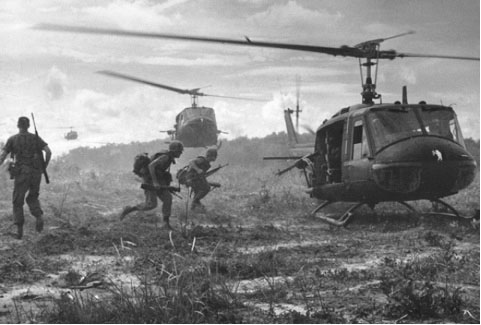
Helicopters created a new mode of warfare, and light and fast were its hallmarks. Old rifles were not needed or desired, at least not by those at the top.
US ARMY PHOTO

The big advantage of the M16 was that a soldier could carry many more rounds than he could of 7.62. Dropped off in the middle of nowhere, and with resupply uncertain, lots of bullets is a good thing. US Army photo.
US ARMY PHOTO

The first M16s to arrive came to Vietnam lacking cleaning equipment. Grunts figured out how to cope.
US ARMY PHOTO
I have wondered if the cause and effect is the reverse of what we have long thought. After all, the testing that produced the 1/7 twist rate was ongoing, and the ballisticians who produced the M856 could well have known that, and used every bit of its stabilizing effect, to produce a tracer round that burned “all the way out there.”
But, we need to move on.
The result, in the late 1980s, was a service rifle that was not at all like the one issued in 1971. The M16A2 was longer, heavier, balanced differently, and had a sighting system that fairly begged to be used at ranges well beyond what was considered the new normal; infantry doesn’t generally shoot people with rifles past 300 meters. That, too, took another twenty years.
The first wake-up call came in Somalia, the running gunfight in Mogadishu, where our troops reported repeatedly shooting people with “green tip” (the M855 has a green-painted tip to identify it) and having those people keep running or keep fighting, or not really pay much attention. In ballistic parlance, the bullet was so stable it passed through without overturning, and thus created wounds not unlike being stabbed with a sharp knitting needle. Not that that is any fun (I do not speak from experience) but it certainly does not greatly discourage the motivated armed combatant.
But, ballistics is both a science and an art, and the prevailing ethos in the military, for the most part, has been managerial for a couple of generations now. (Some branches, more than others.) People practice, train and do what they are graded on, and no-one was being graded on small arms effectiveness. So it should not have come as a surprise when, almost a decade later, the same complaints were voiced in Iraq and Afghanistan.
Meanwhile, Colt was still trying to move things forward. They realized by the early 1990s that the M16A2 was too long, too heavy and too bulky for some end-users. But they could not convince the Army to do anything. So they did it themselves. They spent their own money, and did the work on their own time, to produce a de-bugged, reliable, carbine version of the M16A2, which Colt called the M4.
The repercussions of that course of action are still being felt, twenty years later. You see, the M16A1, and the A2, having been government-initiated and developed, belonged to the government. If the Department of Defense wanted to source the M16A2 from an extra, replacement, or competitive manufacturer, Colt had one choice – suck it up and compete for the bid. That’s why, if you get a chance to see some M16A1s up-close, don’t be surprised if you see some marked “Hydramatic.” Yep, made by the division of GM, during the Vietnam war, as an additional source to Colt. Later, M16A2, 3, and 4 models can be found marked by FN, out of South Carolina. DoD invited bids, and FNH-USA has won some. A lot, in fact. But the Technical Data Package (TDP in mil-speak) of the M4 was not paid for, nor developed by DoD. It was paid for by Colt, and thus belonged to them.
Colt offered the M4 to the military as an individual product, not a weapons system as part of a request for proposal, etc., and some units jumped on it, because it was a good thing to have. When it became known, more units had to have it, but budgets and TO&E limited adoption. (More mil-speak: TO&E, Table of Organization and Equipment. If the TO&E says your unit needs/uses/gets M16A2s, it doesn’t matter that in a rational world, the better-tool-for-you M4 would be a no-brainer decision. You get M16A2s.)
FNH USA entered the bid for M16A2/A3/A4 contracts, won, and became a competitor to Colt for those products. But, the M4 was a sole-Colt product, since the TDP was Colt’s. If the DoD wanted to get other bidders for M4 contracts, they would first have to buy the TDP from Colt. (Now that would have been an interesting discussion to watch.)
Further complication: The government screws up. In the process of letting out bids for accessories to go onto M4 carbines, the DoD sent copies of the Colt-owned M4 TDP along with the accessory descriptions that the Army wanted. Ooops. While the government was within its bounds asking other companies to bid on extras, they did not own the TDP, and could not hand out copies of it to third parties.
This is where having good attorneys on hand is a good thing. Colt got the copies back, and the requirement that any knowledge those third parties might have gained, not be used. And more, Colt got exclusive use of the TDP for a specified period of time (up to 2009 as I recall) and afterwards, the government could use it and issue it.
But here’s the fun part – any third party who uses the TDP post-2009 can use it only for a government contract (they can’t improve their own civilian-market product, using the TDP) they can’t make an M4-based product for non-DoD sale, and when the contract is done, they have to destroy all copies of the TDP they possess.
And as a capper, Colt also collects a royalty for all M4 production by third parties, to government sales, for a time period (don’t know the time, but I’d bet twenty years from 2009) in the future. Colt could very well give up M4 production for the government, focus solely on civilian sales, and still make money on each M4 that goes to the DoD or overseas. Damn, that Colt attorney earned his yearly bonus.
Meanwhile, back at the end of the 20th century the failed Assault Weapons Ban of 1994 was causing all kinds of consternation.
Colt, by this time, was basically out of the non-military firearms production business. The ban caused more interest in ARs than had existed before. As a result, a lot of people jumped in to make them. After all, unlike the traditional firearms manufacturing process, the AR was much more of an industrial product than many firearms designs had previously been. Plus, with receivers made of aluminum, it was possible to re-program a CNC machining station to machine the forgings. Unlike traditional firearms production, where a part that required twenty machine cuts, and thus twenty mills, each set up for its one cut, one CNC machine could do all twenty. Or forty, a hundred, or more.
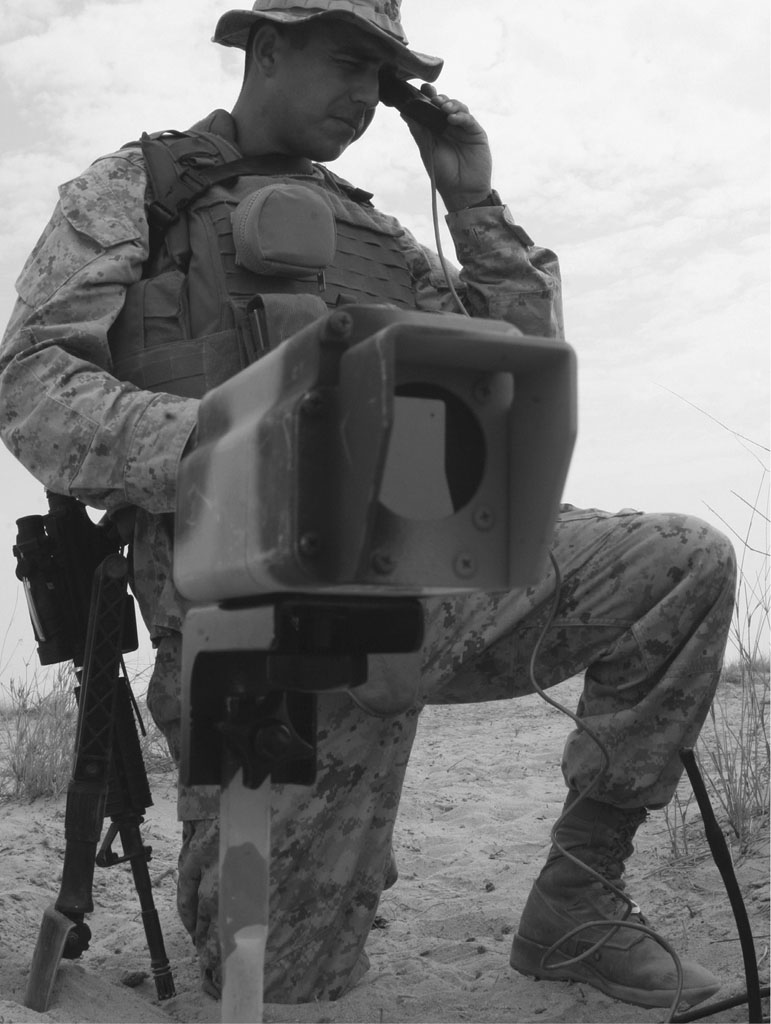
The gov mandates a flash hider not just to hide flash. Rifles get a lot of abuse in real-world use, and a smart designer knows that. Lance Cpl. Jaime J. Sweeney (no relation to author), radio operator for the 26th Marine Expeditionary Unit’s Ground Sensor Platoon, checks the field of view from a camera.
PHOTO BY USMC CPL. AARON J. ROCK
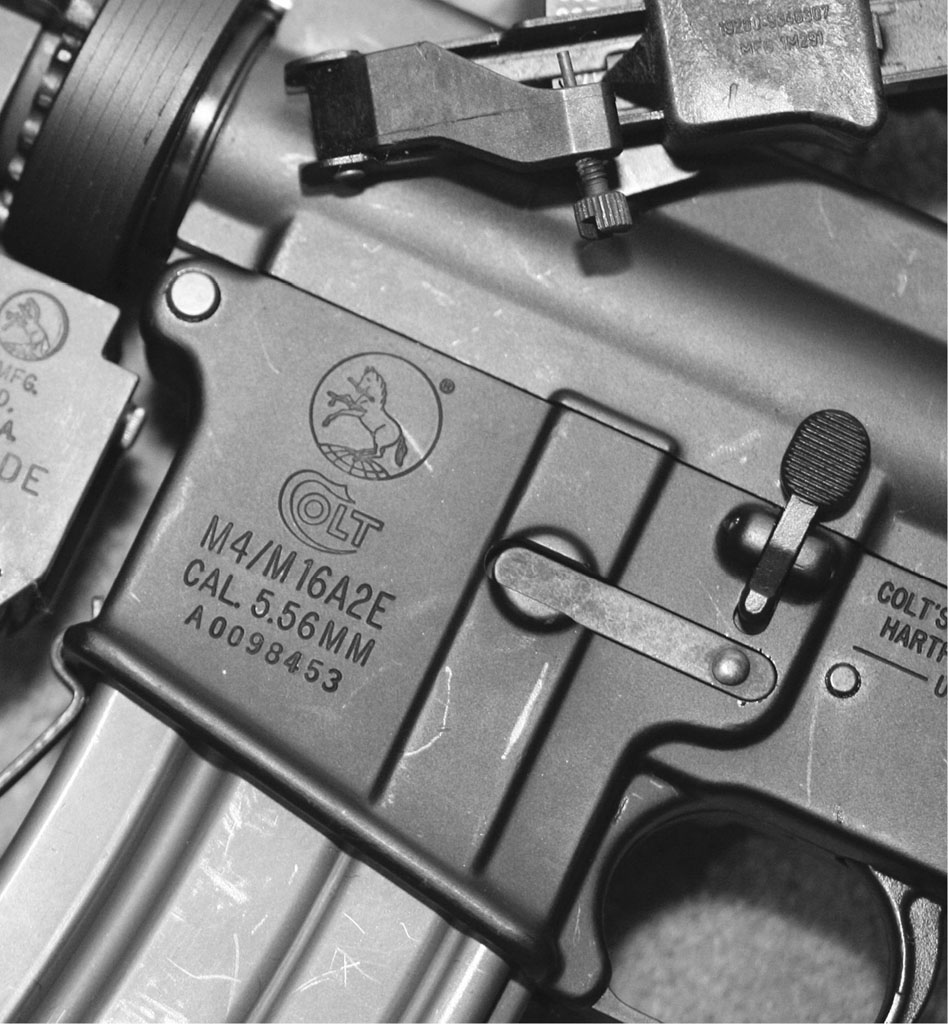
Colt made the M4, they own it, and they now can collect royalties from other makers who supply M4s in the future to the government. Nice work, if you can get it.

Fashion and need may dictate desire, but you use what you have. Everyone wants an M4, but the government has warehouses full of M16A2s. U.S. Army 1st Lt. Spencer Tadken reviews aiming techniques with an Afghan soldier during training at Forward Operating Base Shank.
DOD PHOTO BY SPC. TIA SOKIMSON, U.S. ARMY.
A brief bit of background on forgings. The process involves heating aluminum bar stock, of a specified alloy, of a given diameter, to a certain temperature, and then holding it in place (with long tongs, obviously) while a big steel die slams down on it. The hot, plastic metal is forced into the shape of the inside of the die, and the grain of the metal is aligned according to the shape of the die.
The temperatures involved and the amount of force slammed down depend on the particular alloy. The amount of grain change induced depends on force, alloy, temperature and shape. The production rate depends on operator experience and investment in proper machines.
The forge machines are heavy, and require huge power to work. (Slamming a multi-ton piece of steel up and down in a controlled manner is not something you do with a 5-hp gasoline engine.) A forge company wants to keep the machines running 24/7. The only way they make money is by forging metal. So, let’s say Colt has a government contract, and needs “X” number of upper and lower forgings a year. If that does not represent full utilization of the forge shop’s output, the forge company will look for more work. That is the nature of heartless capitalism; the company has to pay its bills, and the fact that Colt doesn’t need all their output is the problem. And that Colt does not want others to be making AR rifles is not the forge company’s problem.
If you want to make ARs, you can walk in, checkbook in hand, and buy the time to make forgings. However, what you can’t do is have your forgings made with the dies Colt paid for. You have to either use the shop’s dies (which they paid to have made, for just such an occasion) or pay for your own dies. Dies can be “cheap” and only cost $10,000. Or they can cost more, a lot more.
Well, with everyone wanting ARs, and Colt not in the business, really, in the 1990s, there were several someones who were willing to pony up the money for dies. Some forge companies made their own, to sell to anyone who wanted to buy forgings, and some AR manufactures paid to have their own dies made, for their own forging supply.
Ten years from the enactment of the AWB/94, when it expired (and don’t think we can ever trick the anti-gunners into that again), there were more AR makers than there had ever been, and the quality was higher than ever. They were not, however, mil-spec. A clever engineer could copy a mil-spec part (without the drawings, the plus-or-minus dimensions, the testing protocols), and they could come close, but they could not be mil-spec. But in many instances, they were better than mil-spec.

A rifle good to a thousand yards wasn’t of much use when the expected engagement distance was barely more than a stone’s throw away.
US ARMY PHOTO
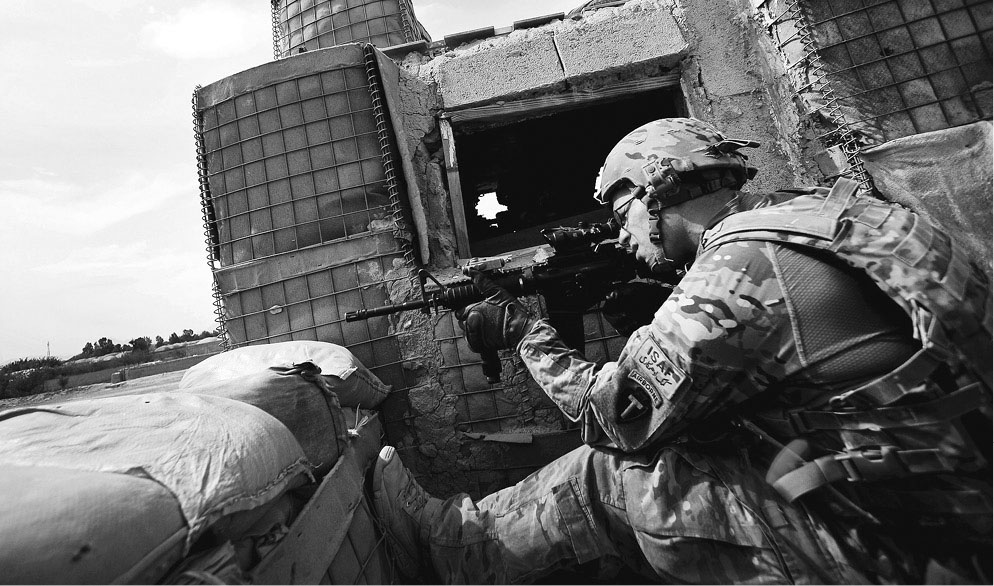
A rifle isn’t just a bullet-launching tool these days, it is an observation optics rest, a laser guidance stick, a ten-pound burden when your real weapon is a radio. U.S. Army Staff Sgt. Mark Scott uses his weapon’s scope to scan the area while providing security from his battle position during an escort detail at Forward Operating Base Farah.DOD PHOTO BY STAFF SGT. JONATHAN LOVELADY, U.S. AIR FORCE
In the same timeframe, a new type of sport burgeoned: 3-gun. I had been shooting 3-gun matches at my home club since the very early 1980s. I had shot in the second USPSA 3-Gun Nationals in 1995. That match was well-attended for a new event, in a strange (Long Island, NY) location. It grew so fast that by the time the 2002 3-Gun Nationals came about, the match was full long before it even started. Today there are TV shows devoted to 3-gun (and its evolution, multi-gun) but the time between the rise and the fall of the AWB got a lot of people interested. Plus, because they were interested in the competitive use of the AR, they were not bound by the traditional mil-spec limits.
With the sunset of the AWB/94, and with every political twist since, AR sales have increased.
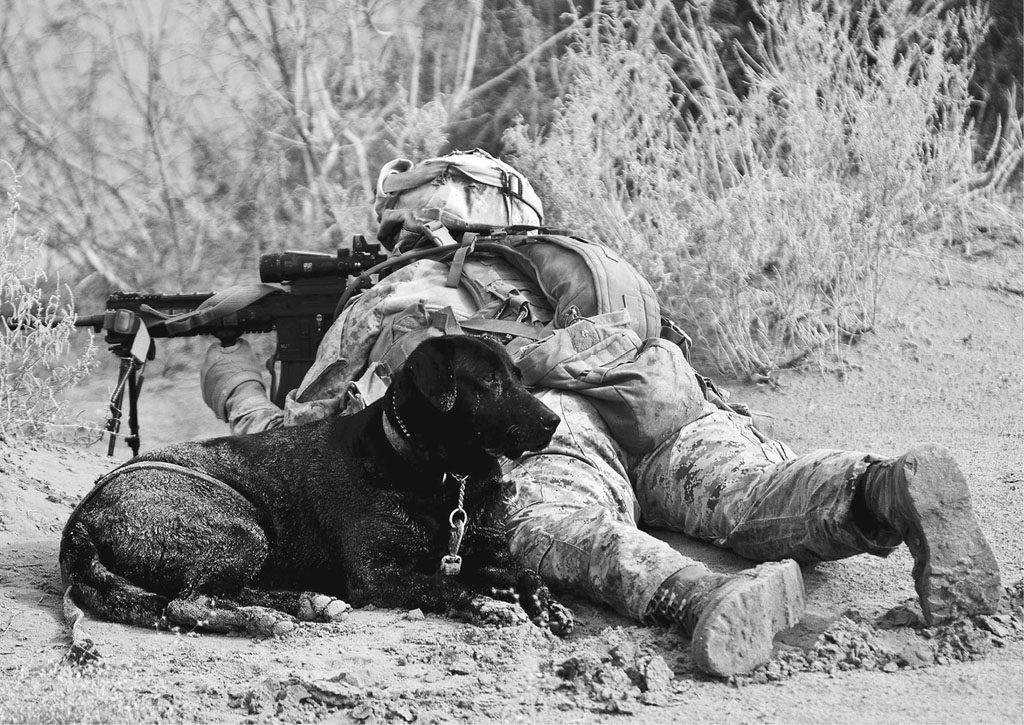
Soldiers and Marines have a lot of gear to haul, keep track of and use. And some of them even have more. Personally, I’d see that dog handlers were all issued suppressors, but that’s just me. U.S. Marine Corps Lance Cpl. Brandon Mann uses his rifle’s scope to scan the area while providing security with his military working dog, Ty. Ty is an improvised explosive device detection dog.
DOD PHOTO BY CPL. ALFRED V. LOPEZ, U.S. MARINE CORPS.
An interesting parallel happened in the US Army Marksmanship Unit. Until the mid-1990s, the Army had been using M14s for High Power competition. A new commander came in and basically said, “That isn’t the issue rifle any more, we’re going to use what we’re issued.” Where civilian competitors had been testing ARs, and tuning them for High Power for a few years, the Army had to undergo a crash course in making them accurate to 600 yards. They succeeded. Within a couple of years, it was rare to see anything but an AR on the course at Camp Perry. In an interesting reversal, the .30 rifles became so sparse the NRA created a new, retro division competition, and set up matches just for.30 rifles.
Through it all, tales of failed M16s in the jungle have haunted the AR. And lousy accuracy, and fragile parts. And it is no longer true. A properly-built AR, using good (and not even the gold-plated best) parts is as reliable as any other self-loading rifle made. A recent test (not done by me, but I was not surprised by the results) had an array of AR carbines (16” barrel, telestock, more-or-less mil-spec) firing ten thousand rounds, each one of them one doing so without a failure. The one that did not fail was fed top-grade, commercial, new ammo in brass cases. The ones fed various steel-cased surplus had malfunctions, induced by the ammo. By then the bores on all were worn to the point that they were no longer accurate enough to pass anyone’s acceptance test, but they still worked. I’ve had similar results.
In other titles from Gun Digest, I have shoveled dirt, sand and snow into and onto ARs, and they worked. Dunked them in water, shot them dripping with oil or bone dry, and they worked. The rifle works.
The biggest cause of malfunctions in the AR? You. That is, you building it wrong, assembling it wrong, treating it wrong, or feeding it crappy ammo, or good ammo from cheap, crappy magazines. If your AR doesn’t work, the likely problem is staring at you from the nearest mirror.
A cheerful thought, yes?
And, the AR-15 now stands as the most popular rifle in America, for reasons not just political. Not that politics are excluded from its popularity. Oh, and if someone objects to the characterizations as “most popular” consider this: Winchester has been selling the M-1894 rifle and carbine since, oh, 1894. Most in .30-30, and as such considered the premier and traditional deer rifle in America for the entire 20th century. In various calibers, design variants and production changes, it has, in (as of this typing) sold over seven million units in 120 years.
The AR-15 has been around less than half that time. And for several decades it was a marginal seller in many gun shops. Sales have now exceeded six million, most of that in the last two decades, a million of those in the last five years, perhaps.
Why, besides politics?
Simple. Unlike earlier rifles, the AR-15 is the ultimate do-it-yourself rifle, a rifle that can reflect the owners character and desires. Do you want to own an AR that is done all in pink, with Hello Kitty decals on it? You can have it. (And yes, you can have it, I don’t need it.) Do you want a small caliber or large, a short rifle or a long and heavy one? Do you want a short-range, quick-handling rifle, or something stable for long-range target and varmint control? You can build it.
Oh, and here’s another measure of just how popular the AR-15 has become: the Brownells catalog. Brownells offers parts, accessories and tools for gunsmithing, gunsmiths and the home gun-plumber. I first encountered a Brownells catalog in 1985. I don’t remember how big it was in total, but it did not have an AR-15 section. What it had were a few offerings of AR receivers, barrels, parts and such, each in the “appropriate” section. That is, you’d have to pore through the Barrel section to find AR barrels. Then switch to the Receivers section for receivers. Ditto magazines, scope mounts and so-on.
The latest Brownells catalog thumped onto my doorstep as I was wrapping up this book. The first 89 pages are devoted to nothing but AR-15 parts, tools, accessories and extras, in the AR-15-only section. 89 pages. In 1985 you could improve your AR a bit by shopping in the catalog. Now, you can build an entire AR from scratch, just ordering from the catalog. (FFL required for the lower, of course.) That’s how far we’ve come.
In that regard, the AR-15 is much like the personal computer of the late 1980s and early-to-mid 1990s. At the time I was going to both gun shows and computer shows. And the parallels of attendees poring over specs, purchasing parts, and building the AR-15/PC to just the specs they wanted, were interesting. PC gamers would get smoking fast hard drives (measured in megabytes back then, not gigabytes) video cards and hulking cpus, all driven by power systems with fans, heat exchangers and more. CAD/CAM people would get less-speedy cpus, but spend more on bigger hard drives, and buy the power system that was rated as most stable, since the PC would be running all night, crunching data.
At the gun shows, buyers would be finding the accessories that Colt could not or would not make, and plan on building their ARs into configurations that weren’t in the Colt catalog. (Which was pretty sparse back then.)
All that exploded after the AWB/94 expired, driven by the expansion of smaller companies who offered the accessories, and by the pent-up demand of shooters to build their rifles the way they wanted, not hampered by nonsensical cosmetic restrictions.
Oh, and in an interesting aside, the military actually caught up, some. It was not unusual in the ‘aughts to see photographs from Iraq and Afghanistan with soldiers and marines (and Airmen, too) packing M4s, M16s that would have been pretty useful 3-gun rifles from the mid-1990s. You know, back in the 1990s, when all optics were “too fragile for combat” and real men shot iron sights? When bolting a light to a handguard was the height of mall-ninja-tomfoolery (although the mall ninja would not be invented for a decade). It is sometimes amusing to have an ex-service person teaching me how to use gear I helped invent, by competing with the guys who were developing it.
But, the ad-hoc nature of the change meant that many of the old myths, the “everybody knows” things that weren’t true, were not addressed. Even as shooters were fine-tuning, problem-solving and building reliable, accurate ARs, no-one was in a position to point out that this was happening.
So, this volume is aimed primarily at the million or so new users, the shooters who haven’t had a lot of time to get familiar with the AR-15. And also at the experienced users – shooters who know some, but have been working in a fog of “everybody knows” and “it has always been”.
Along the way, this volume will correct the misconceptions you may have about the AR. It will also tell you how to inspect, test, correct and maintain your rifle, your new investment.
You see, in the anti-gun battle, there are a whole lot of people who are in the middle, who don’t care, and want to be left alone. However, every time someone who was otherwise in the middle buys an AR, they’ve made a choice. Where before they could be moved by rhetoric, mere or soaring, now they have made a thousand-dollar investment on one side. Sometimes more, even a lot more. And if the law changes, they will lose that investment. So, for all of you who have newly made that investment, here’s how to properly treat your new investment, your new stake, your new AR-15.

The arithmetic is simple: M1 Garand, 8.5 ounces for eight shots; M14, 24 ounces for 20 shots. The M16? 19 ounces for 30 shots. A load of seven magazines and an M16 weighed less than an M1 Garand and seventeen clips. The M14? It could do the rifle, a mag in the rifle and four spare magazines. No contest.